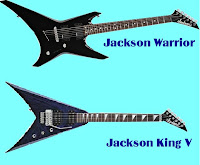 |
| Wayne Charvel |
| Grover Jackson |
Charvel sold the business to Jackson
The company had been building guitars under the Charvel name, and had built up a good reputation, so Jackson
| NAMM Jackson display |
If you are unfamiliar, NAMM, the National Association of Music Merchants, holds a trade show twice a year (it might have been once a year in the 1970’s) so that manufacturers of musical instruments and related products can display the wares to wholesalers and retailers. It has grown over the years, and one can bump in to not just the merchants, but also some of the world’s great players.
These were the days leading up to Heavy Metal Music. Marshall
In 1980, the management of Ozzy Osbourne’s band, Black Sabbath asked Jackson Randy Rhoads Jackson and Rhoads got together for dinner and lay down their plans for the style of what would later become the Jackson Concorde
The guitar was sketched on a paper napkin. It was V shaped with an offset and very angular. The distinctive six-on-a-side headstock bore the Jackson Jackson
Rhoads began using this instrument in concerts, but soon asked for changes to the guitar. The second version is the Randy Rhoads Concorde
| Charvel guitar |
The more traditional looking Charvel guitars continued to be manufactured; however, Metal players preferred the radical looking Jackson
This was the era of the Super-Strat. Many of these guitars were loosely based on a Stratocaster design, but had smaller bodies and pointy horns, the necks were fast, the pickups were wound to be hot, and the headstocks pointed down or upwards.
Many of the Jackson
| Jackson Dinky |
The Jackson Dinky Jackson
The unique Jackson Jackson and Charvel guitars. You will find a Fender style headstock on current models.
| Charvette |
It was in the 1990’s when music styles changed and Grunge music outpaced Metal. Grunge players favored cheap old guitars. The era of pointy guitars and hair bands for the most part ended.
Fender has maintained the same look and feel of traditional Jackson guitars.
Ibanez guitars copied the look of Charvel Jackson
| Soloist |
Besides the Rhoads and Dinky guitars, some other models worth mentioning are the Soloist, which came with a neck-thru body and a super strat design, the Kelly , which was based on the Gibson Explorer, the King V, which had a symmetrical V style body with long wings and the Warrior with four pointy ends on the body.
 |
| Jackson Kelly |
During the time that Jackson Glendora , California Charvel Jackson Ontario , California
The address listed on the back of some of the



Tidak ada komentar:
Posting Komentar